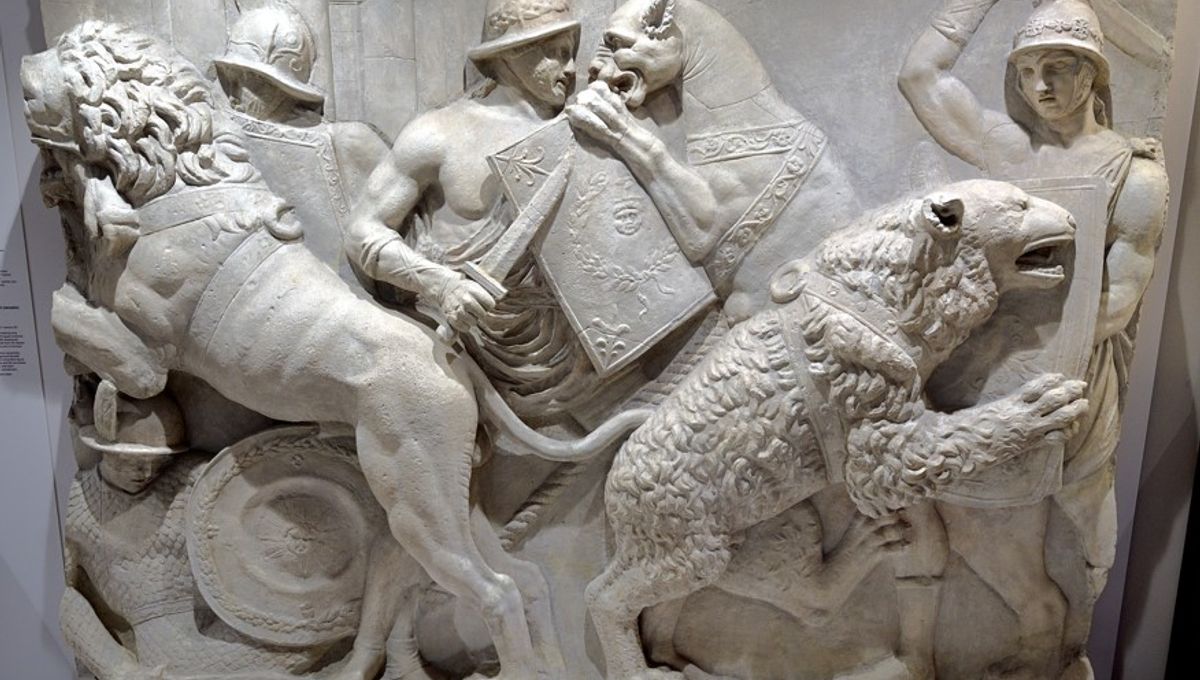
A Roman-era skeleton from York, northern England, shows signs of having been bitten by a big cat, thus providing the first archaeological evidence that gladiators did battle with lions and other terrifying beasts. Previously, these fabled human-animal contests were only known from written and artistic sources, leading many scholars to question whether the brutal encounters actually took place.
“What I hadn’t appreciated when I started this work was that there is no physical evidence of gladiators fighting animals, anywhere in the world,” Professor Tim Thompson, lead author of a new study about the discovery, told IFLScience. “All we have are drawings, paintings, and mosaics”.
For instance, in Yorkshire, a mosaic found at a Roman villa in the village of Rudston depicts a lion, a leopard, a bull, and a stag next to the insignia of a corporation of famed “arena hunters”. Yet very few actual remains of large animals have ever been recovered from Roman amphitheaters, with a scattering of leopard bones in Serbia representing the only example in Europe north of the Alps.
We’re quite confident that these are gladiators.
Professor Tim Thompson
However, when excavating a cemetery at Driffield Terrace in the Roman city of Eboracum – which is now York – the study authors noted that the bodies all belonged to young men showing signs of physical trauma. Intriguingly, many of these injuries matched those found on skeletons from the gladiator cemetery of Ephesus in Turkey.
“When you look at the demography of the graves, the healed trauma, the nature of the decapitations, all of that is very unusual when we compare that to bodies from other Roman cemeteries,” says Thompson. “But when we compare it to bodies from Ephesus, for example, then they’re really kind of similar. So we’re quite confident that these are gladiators.”
Remarkably, the researchers also noted a series of depressions on the pelvis of one of the skeletons that looked like bite marks. After creating 3D scans of these indentations and comparing them to the tooth-prints of several large animals, they concluded that they were most likely made by a big cat such as a lion.
However, because lions typically attack the head or neck of their prey, the study authors speculate that the bites “were not part of an attack per se, but rather the result of scavenging at around the time of death.” Indeed, the skeleton has also been decapitated, although Thompson says it’s unclear exactly how this unenviable individual was dispatched.
“I don’t think it’s the fatal bite,” says Thompson. “The positioning, the depth of the injury and the cleanness of the bite marks suggests that this isn’t someone who’s struggling or fighting [with the lion],” he continues.
“So it could be that this individual has been incapacitated through some other means, and [the bite marks] are indicative of the lion dragging the body away.”
Regardless of how it all went down, it’s clear that this unfortunate soul – who died some time in the third century CE – had a pretty miserable time in the arena. More significantly, the findings provide validation for historical accounts of gladiatorial “beast hunts” – known as venationes – which pitted humans against dangerous animals.
Alternatively, the mangled skeleton may represent the remains of a convict who was sentenced to a particularly brutal form of execution known as damnatio ad bestias, whereby death was inflicted by wild animals for the amusement of a baying crowd.
“This latest research gives us a remarkable insight into the life – and death – of this particular individual, and adds to both previous and ongoing genome research into the origins of some of the men buried in this particular Roman cemetery,” said David Jennings, CEO of York Archaeology, in a statement.
“We may never know what brought this man to the arena where we believe he may have been fighting for the entertainment of others, but it is remarkable that the first osteo-archaeological evidence for this kind of gladiatorial combat has been found so far from the Colosseum of Rome, which would have been the classical world’s Wembley Stadium of combat.”
The study is published in the journal PLOS ONE.
Source Link: First Ever Evidence Of Roman Gladiators Fighting Lions Discovered In Britain